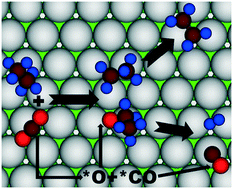Mechanistic study of dry reforming of ethane by CO2 on a bimetallic PtNi(111) model surface†
Abstract
Ethane (CH3CH3), one of the primary components of shale gas, is an attractive candidate for the production of syngas (CO + H2) and ethylene (CH2CH2) via the selective C–C and C–H bond cleavage, respectively. Understanding the origin of the selective conversion is essential to the design of a good catalyst for CH3CH3 activation. Herein, we combined density functional theory (DFT) calculations with kinetic Monte Carlo (KMC) simulations to shed light on the mechanism of the oxidative C–H and C–C bond cleavage of CH3CH3 on a PtNi(111) model catalyst using CO2 as an oxidant, where the estimated selectivity is in good agreement with the experimental results on PtNi nanoparticles supported on CeO2. Our calculations show that PtNi is selective to CO via direct CO2 dissociation and the oxidative C–C bond scission of CH3CH3via the oxygenated (*C2HyO) intermediates. By comparison the CH2CH2 selectivity via the selective C–H bond scission of *CH3CH3 is much lower. The kinetic analysis suggests that the selectivity of PtNi toward syngas can be enhanced by facilitating the formation of key *C2HyO intermediates, while the selectivity toward CH2CH2 is promoted mainly by accelerating the C–H bond scission of *CH3CH2 to produce *CH2CH2.



 Please wait while we load your content...
Please wait while we load your content...
